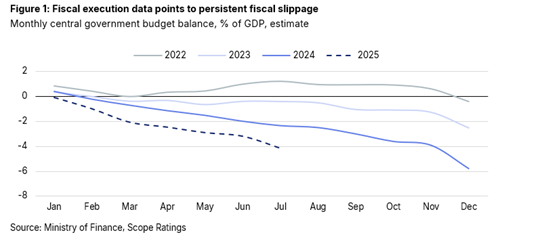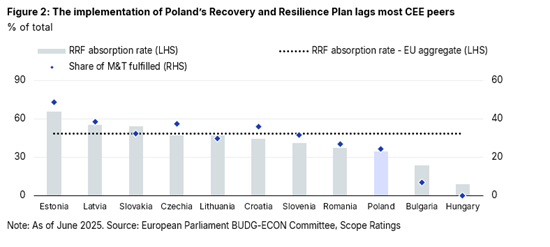Announcements
Drinks

Poland: fiscal slippage contained by EU financing; political divides impede budget consolidation
By Jakob Suwalski and Brian Marly, Sovereign and Public Sector
Poland’s (A/Stable) strained fiscal position – characterised by deficits near 7% of GDP in 2025–26 and rising public debt ratio – weigh on its credit metrics. However, robust GDP growth and concessional EU support, notably remaining RRF funding and SAFE loans, are easing the government’s financing burden.
Poland’s annual growth is expected to reach 3.4%–3.5% in 2025–26, underpinned by domestic demand and EU-driven investment, with annual inflation moderate, averaging 3% by 2026, and unemployment stable at about 5%.
However, Poland’s sovereign credit strength also hinges on how effectively it manages geopolitical risks and implements spending on defence as Russia’s hybrid warfare against NATO members intensifies.
Poland’s revised 2025 deficit forecast of 6.9% of GDP (up from 5.5%) reflects underperforming VAT and excise receipts, alongside record defence outlays of PLN 200bn (4.8% of GDP) and structurally high social transfers. Central government budget execution to August underscores these pressures. Tax revenues amounted to only 56% of the full-year plan, due to a decline in personal income tax receipts and lower VAT growth on weaker consumption.

Bank tax proposal: a test of Poland’s ability to tap additional revenues amid institutional divisions
The 2026 draft budget foresees only a modest narrowing of the fiscal deficit to 6.5% of GDP, with revenues lifted by higher bank taxation and improved tax collection, but expenditure effectively flat at PLN 919bn.
The government has proposed a temporary increase in the corporate income tax for banks, set at 30% in 2026, before decreasing to 26% in 2027 and 23% in 2028, alongside a phased reduction of the bank asset tax.
Associated revenues are earmarked for defence spending and are projected to raise PLN 6.5bn in 2026 and over PLN 20bn cumulatively in the next decade. As such, the proposal would do little to materially improve the upward trajectory of Poland’s medium-term spending, which is dominated by structural commitments to defence, pensions, and welfare.
While extra tax income could strengthen short-term buffers, execution risks are significant, as Prime Minister Donald Tusk’s government faces potential vetoes from President Karol Nawrocki, who so far has blocked tax increases on personal income and SMEs. This makes the proposed bank tax a test of whether Poland can realistically tap additional tax revenues.
With the next parliamentary elections due in 2027, politically driven spending commitments are likely to increase rather than diminish.
Poland’s debt outlook: rising burden and off-budget financing
Poland’s debt metrics are set to deteriorate. Under the national definition, debt is projected at 54% of GDP in 2026, versus around 66% under the EU measure, a 12pp gap reflecting extensive off-budget financing via the special BGK and PFR funds. Originally expanded during the pandemic, the funds are now used for defence and welfare, deferring fiscal pressures while keeping the national ratio below the 60% ceiling.
The 2026 budget caps debt service at PLN 90bn (2.2% of GDP), with costs projected to rise from 1.9% of GDP in 2024 to 2.6–2.7% by 2029, while declining fiscal buffers increases pressure for consolidation through spending restraint or revenue measures. State public debt is set to increase from 48.9% of GDP in 2025 to 59.5% in 2029. It would breach the 55% prudential threshold in 2028, thereby triggering compensating public-sector wage freezes, stricter pension indexation and a balanced budget rule from 2030, while remaining below the constitutional 60% cap.
Even so, funding risks remain contained: net issuance will remain broadly stable at around PLN 300bn in 2026 (excluding RRF loans), while nearly 90% of bonds are held by domestic investors, underpinning market stability and confidence.
SAFE: a structural credit buffer
Poland stands to receive around EUR 50bn under the EU’s SAFE instrument (5% of GDP), a major credit positive given projected fiscal deficits of 6%–7% of GDP in 2025–26. Unlike Cohesion Funds, SAFE loans are concessional, with long maturities, below-market rates, and euro-denominated disbursement which helps ease refinancing needs and support investor confidence by highlighting Poland’s strategic role in EU security. If efficiently absorbed, SAFE inflows could offset almost a full year of fiscal deficit, materially cushioning external vulnerabilities though at the cost of increasing overall debt.
SAFE inflows are essentially additional, but they provide leeway to reduce reliance on capital markets. While the exact disbursement profile has not been published, based on typical EU practice we assume 10–15% pre-financing in 1H 2026, with subsequent tranches tied to milestones.
However, Poland’s relatively low RRF absorption rate (35% vs. EU average of 49%) reflects earlier delays linked to rule-of-law conditionality and the government’s decision to backload reforms and investments into 2025–26. With nearly 60% of allocations due in 2026, execution risks are significant, though inflows could still partially ease cash deficits if expenditures have already been pre-financed. The uncertain timing, however, leaves Poland exposed to financing shortfalls should the government miss its targets.

Scope’s next review date for Poland is 14 November 2025.






